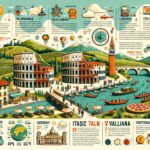Italy, known for its rich history, art, and cuisine, is a popular tourist destination attracting millions of visitors each year. However, due to the ongoing COVID-19 pandemic, travel restrictions have been put in place to ensure the safety of both tourists and locals. In this article, we will take a closer look at the latest travel restrictions in Italy and how they are impacting travelers.
Italy has a long-standing reputation as one of the most sought-after travel destinations in the world. With iconic cities like Rome, Venice, and Florence, as well as picturesque landscapes and historic landmarks such as the Colosseum and the Vatican, it’s no wonder why so many people choose to visit Italy. However, with the outbreak of COVID-19, the tourism industry in Italy has taken a hit.
The pandemic has forced governments worldwide to implement strict measures to control the spread of the virus. This includes travel restrictions that limit entry into countries or require quarantine upon arrival. As such, Italy has also implemented its own set of travel restrictions in order to mitigate the impact of COVID-19. These restrictions include visa requirements, entry regulations, quarantine measures, mandatory COVID-19 testing for travelers, and potentially vaccine requirements or exemptions.
As you plan your trip to Italy amidst these latest travel restrictions, it is important to stay informed about any changes or updates that may arise. In this article series, we will provide you with all the necessary information regarding the current travel situation in Italy.
From understanding the background and importance of tourism in Italy to exploring the latest travel restrictions imposed by the Italian government and providing useful tips for navigating through them successfully – we’ve got you covered. So let’s dive in and discover what you need to know before embarking on your Italian adventure.
Background
Italy has a rich history and culture that has made it one of the most popular tourist destinations in the world. The country’s tourism industry has played a significant role in its economy, contributing to job creation and revenue generation. According to the World Travel and Tourism Council, travel and tourism accounted for approximately 13% of Italy’s GDP before the COVID-19 pandemic.
Italy is known for its historical sites such as the Colosseum in Rome, the Leaning Tower of Pisa, and the ruins of Pompeii. The country also boasts beautiful landscapes like Tuscany’s rolling hills and the stunning Amalfi Coast. Its cuisine and fashion are renowned worldwide, attracting food enthusiasts and fashionistas alike.
Tourism has long been an integral part of Italian culture. It started during ancient times when people would visit Rome to witness gladiator battles or explore important historical sites. In later centuries, Italy became a popular destination among wealthy Europeans undertaking grand tours to admire art collections, architecture, and cultural landmarks.
Today, tourism continues to be a crucial sector for Italy’s economy. Before the COVID-19 pandemic, millions of tourists visited Italy each year, contributing billions of euros to local businesses and supporting jobs in various industries such as hospitality, transportation, and retail.
However, the pandemic brought international travel to a standstill, severely impacting Italy’s tourism industry. In response to rising cases of COVID-19 globally, Italy implemented travel restrictions to control the spread of the virus within its borders. These measures included entry bans for non-essential travel from certain countries and mandatory quarantines for incoming travelers.
The consequences of these restrictions were felt throughout Italy’s tourism ecosystem. Hotels sat empty, restaurants struggled to attract customers, and tour operators faced massive cancellations. Small businesses that relied heavily on international visitors suffered heavy financial losses.
While these restrictions have undeniably had a negative impact on Italy’s tourism industry and economy as a whole, the country has been gradually reopening its borders and easing travel restrictions in accordance with improving health conditions and vaccination efforts. As Italy adapts to the challenges presented by the pandemic, it is crucial for travelers to stay informed about the latest updates on travel restrictions and plan their trips accordingly.
Travelers visiting Italy should be prepared for potential changes in entry requirements, COVID-19 testing protocols, and quarantine measures. It is also essential to check with Italian diplomatic missions or official government websites for the most up-to-date information before making any travel arrangements.
COVID-19 Impact
The COVID-19 pandemic has had a profound impact on the tourism industry in Italy, leading to the implementation of strict travel restrictions. Italy is renowned for its rich history, cultural landmarks, and vibrant cities, making it one of the most popular tourist destinations in the world. However, with the emergence of the pandemic, these attractions suddenly became inaccessible to international travelers.
Italy relies heavily on tourism as a significant source of revenue and employment. Before the pandemic, tourism accounted for a significant portion of Italy’s GDP, with millions of visitors flocking to iconic sites such as Rome’s Colosseum and Florence’s Uffizi Gallery. The sudden halt in inbound tourism due to travel restrictions has dealt a severe blow to businesses that depend on this sector.
In response to the spread of COVID-19, Italian authorities implemented various measures to limit the virus’s transmission and protect public health. These measures included strict lockdowns, closures of borders, and limitations on domestic and international travel. The implementation of travel restrictions was necessary to curb the spread of the virus and prioritize public safety. While these measures have been effective in controlling infections and reducing strain on healthcare systems, they have severely impacted Italy’s tourism industry.
Tourism-related businesses, such as hotels, restaurants, tour operators, and attractions faced significant declines in revenue due to decreased visitor numbers. Many establishments were forced to close temporarily or permanently as a result. The financial impact on individuals working within this sector has also been substantial since many rely heavily on tourist spending for their livelihoods.
The overall economic downturn caused by travel restrictions has had ripple effects beyond just those directly involved in tourism. Related industries such as transportation (airlines and railways) also suffered due to reduced passenger demand. Additionally, local economies that depend on tourists’ spending saw their own revenues decline significantly.
As Italy gradually eases travel restrictions and reopens its borders, the tourism industry is slowly recovering. However, it is not without challenges. The impact of the pandemic on tourism in Italy will likely have long-lasting effects that will take time to overcome completely. To ensure a sustainable recovery, there is a need for innovative approaches, support from governments, and a commitment to health and safety protocols to regain travelers’ trust.
The Road to Recovery
Italy recognizes the importance of reviving its tourism industry and has been implementing strategies to facilitate the recovery process. This includes financial support for affected businesses, marketing campaigns to promote domestic and international travel, and investments in infrastructure improvements. The aim is to attract visitors back to Italy while ensuring their safety and well-being.
Adapting to a Changing Landscape
The pandemic has forced businesses in the tourism sector to adapt their operations to meet new health and safety requirements. Hotels have implemented enhanced cleaning protocols, social distancing measures are in place at popular attractions, and restaurants have adjusted seating arrangements to ensure safe dining experiences. These adaptations are necessary for both locals and tourists alike.
Promoting Domestic Tourism
With international travel restrictions still in place for many countries, there has been an increased focus on promoting domestic tourism within Italy. Italians are encouraged to explore their own country’s beauty and culture by taking advantage of special deals or incentives offered by hotels, tour operators, or local authorities.
Despite the challenging circumstances faced by the tourism industry in Italy as a result of COVID-19, there is hope for recovery. It will be essential for all stakeholders – governments, businesses, and travelers – to work together collaboratively towards a robust revival of this vital sector while prioritizing public health and safety.
Latest Travel Restrictions
Italy has implemented a series of travel restrictions in response to the ongoing COVID-19 pandemic. These restrictions are aimed at controlling the spread of the virus and protecting both residents and visitors. It is important for travelers to familiarize themselves with the latest travel restrictions imposed by the Italian government before planning a trip to Italy.
Visa Requirements:
Currently, Italy has not imposed any additional visa requirements for travelers. The usual visa regulations still apply based on the country of origin. Travelers should check with their local Italian embassy or consulate for the latest information regarding visa requirements.
Entry Regulations:
To enter Italy, travelers must fill out a self-declaration form stating that they have not been in close contact with confirmed COVID-19 cases in the past 14 days and do not have any symptoms related to COVID-19. Temperature checks may also be conducted upon arrival.
Quarantine Measures:
Unvaccinated travelers entering Italy may be subject to quarantine measures depending on their country of origin. As the situation is constantly changing, it is essential to check for updates regarding quarantine requirements prior to traveling.
Traveling from EU Countries
As of September 1, 2021, fully vaccinated individuals traveling from EU countries can enter Italy without having to undergo quarantine or testing upon arrival. Those who are unvaccinated or partially vaccinated will need to show proof of a negative COVID-19 test taken within 48 hours before departure or undergo testing upon arrival in Italy.
Traveling from Non-EU Countries
For travelers coming from non-EU countries, different entry regulations apply depending on the country’s classification as a high-risk area or low-risk area. High-risk areas require a negative COVID-19 test result taken within 72 hours before departure and mandatory quarantine upon arrival, followed by another test at the end of the quarantine period. Low-risk areas only require a negative COVID-19 test result taken within 72 hours before departure.
It is crucial for travelers to regularly check for updates and consult official government sources for the most accurate information on travel restrictions before planning a trip to Italy. Compliance with these restrictions not only ensures personal safety but also contributes to the overall effort in controlling the spread of COVID-19.
COVID-19 Testing
As part of the latest travel restrictions imposed by the Italian government, travelers to Italy are required to undergo mandatory COVID-19 testing. These testing requirements have been put in place to ensure the safety of both visitors and residents in Italy and to prevent the spread of the virus.
Travelers entering Italy are required to provide a negative result from a molecular or antigen test taken no more than 48 hours prior to arrival. It is important to note that only specific types of tests are accepted for entry into Italy. The accepted tests include PCR (Polymerase Chain Reaction) tests, RT-PCR tests, LAMP (Loop-mediated Isothermal Amplification) tests, and antigen tests that meet specific criteria outlined by Italian authorities.
The timing of the COVID-19 test is crucial as it must be conducted within 48 hours before arrival in Italy. Travelers should plan accordingly and ensure they have their test results ready and available for inspection upon entry. It is recommended to get tested at an authorized laboratory or medical facility that can provide the necessary documentation for travel purposes.
| Accepted COVID-19 Tests | Criteria |
|---|---|
| PCR (Polymerase Chain Reaction) Test | Must be done within 48 hours before arrival |
| RT-PCR (Real-time Polymerase Chain Reaction) Test | Must be done within 48 hours before arrival |
| LAMP (Loop-mediated Isothermal Amplification) Test | Must be done within 48 hours before arrival |
| Antigen Test | Must meet specific criteria set by Italian authorities |
It is advisable for travelers to check with their local health authorities or the embassy or consulate of Italy in their country for the most up-to-date information on accepted tests and requirements. Additionally, it is important to note that travel restrictions and requirements may vary depending on the traveler’s country of origin, so it is essential to stay informed about any changes or updates.
Vaccination Policies
As Italy continues its efforts to manage the COVID-19 pandemic and ensure the safety of its citizens and visitors, specific vaccination policies have been implemented for travelers entering the country. Currently, Italy recognizes vaccines that have received approval from the European Medicines Agency (EMA), such as Pfizer-BioNTech, Moderna, AstraZeneca, and Johnson & Johnson.
Travelers who have completed a full course of vaccination with one of these approved vaccines are generally exempt from quarantine requirements upon arrival in Italy. However, it is important to note that travelers must provide proof of vaccination in order to qualify for this exemption.
To facilitate the verification process at border control points and ensure seamless travel, Italy has introduced a digital vaccine passport known as the Green Pass. This pass serves as proof of vaccination, allowing travelers to present their vaccine status digitally through a QR code. The Green Pass also includes information about recovery from COVID-19 or negative test results.
In addition to the Green Pass, travelers can also carry paper certificates issued by their home country’s health authorities as an alternative form of vaccination proof. It is crucial for travelers to familiarize themselves with the requirements and guidelines specific to their home countries before traveling to Italy.
It is important to note that these vaccination policies may evolve as new scientific evidence emerges or as Italy adjusts its travel restrictions based on changing circumstances. As such, it is advisable for travelers planning a trip to Italy during this time to stay updated with any changes announced by relevant authorities. By adhering to these regulations and providing accurate documentation regarding vaccination status, travelers can ensure a smoother experience while visiting Italy under the current travel restrictions.
Travelers’ Experiences
As travel restrictions continue to evolve in response to the COVID-19 pandemic, many travelers have been wondering what it’s really like to visit Italy amidst the latest travel restrictions. Fortunately, there are numerous individuals who have recently traveled to Italy and successfully navigated through the current regulations. Their experiences provide valuable insights and a glimpse into what travelers can expect when planning a trip to this beautiful country.
One traveler, Sarah, recently visited Rome with her family and found the process of traveling to Italy quite smooth. She noted that before her departure, she diligently checked the latest travel restrictions on the official Italian government website and made sure to comply with all the requirements.
This included filling out a digital Passenger Locator Form before arrival and having proof of a negative COVID-19 test taken within 48 hours before departure. Upon arrival in Rome, she experienced efficient health checks at the airport, where her temperature was taken, and everyone was required to wear masks.
Another traveler, Michael, explored Florence during his recent trip. He emphasized the importance of staying up-to-date with travel advisories from both his home country and Italy. Michael shared that he booked accommodations that had flexible cancellation policies in case unforeseen circumstances occurred due to changing travel restrictions. He also mentioned that while in Florence, he observed strict adherence to mask-wearing in public places and saw hand sanitizer stations readily available throughout popular tourist sites.
To make navigating through these latest travel restrictions easier for other travelers like Sarah and Michael, here are some tips they shared:
- Stay informed: Regularly check official government websites for updates on travel restrictions.
- Plan ahead: Book accommodations with flexible cancellation policies.
- Obtain necessary documents: Ensure you have all required documents such as digital Passenger Locator Forms or negative COVID-19 test results.
- Follow health protocols: Adhere to mask-wearing and other health and safety guidelines in public areas.
- Pack essentials: Bring hand sanitizer, disinfecting wipes, and extra masks for your trip.
By learning from the experiences of travelers like Sarah and Michael, future travelers can approach their trips to Italy during the latest travel restrictions with confidence and knowledge. Remember, while the situation may evolve, careful planning and adherence to regulations will help ensure a safe and enjoyable visit to one of the world’s most beloved destinations.
Tips for Traveling to Italy
Italy is a popular travel destination known for its rich history, stunning landscapes, and delicious cuisine. However, with the ongoing COVID-19 pandemic, it’s important for travelers to be aware of the latest travel restrictions in place before planning a trip to Italy.
When traveling to Italy during the current travel restrictions, there are several practical tips and advice that can help ensure a smooth and safe journey. Here are some key points to keep in mind:
- Travel Insurance: It is highly recommended to purchase comprehensive travel insurance that covers medical expenses, trip cancellation or interruption, and emergency evacuation. Review the policy details carefully to understand what is covered related to COVID-19.
- Cancellation Policies: Before making any bookings for accommodation or flights, carefully review the cancellation policies of each provider. Make sure they have flexible options in case your plans need to change due to unexpected circumstances related to the pandemic.
- Health and Safety Precautions: Follow all health and safety guidelines issued by local authorities in Italy, as well as those recommended by international health organizations such as wearing masks, practicing social distancing, and frequently sanitizing hands. Stay updated on any specific measures or regulations implemented by the Italian government.
- Entry Requirements: Check the latest visa requirements for entry into Italy and ensure you have all necessary documents ready before traveling. Remember that these requirements might vary depending on your country of origin.
- COVID-19 Testing: Familiarize yourself with the mandatory COVID-19 testing requirements for travelers entering Italy. Understand which types of tests are accepted (such as PCR or antigen tests), the timing of the test (usually within 72 hours before departure), and where you can get tested in your home country.
- Green Pass / Digital Vaccine Passport: Be aware of any specific vaccine requirements or exemptions for travelers entering Italy. The Italian government has introduced a digital vaccine passport called the “Green Pass,” which provides proof of vaccination against COVID-19 or recovery from the virus. Familiarize yourself with the requirements for obtaining and using the Green Pass.
By being prepared and following these tips, travelers can navigate through the current travel restrictions in Italy safely and responsibly. It’s important to stay updated on any changes or updates related to travel restrictions, so it is recommended to regularly check official government websites or consult with a reputable travel advisor.
Remember, while traveling during these times may require extra planning and precautions, it is still possible to have a memorable and enjoyable trip to Italy. With proper preparation and adherence to guidelines, travelers can make the most of their visit while prioritizing their health and safety.
Future Outlook
As the world continues to grapple with the COVID-19 pandemic, there is hope on the horizon for travelers planning to visit Italy. While the current travel restrictions have undoubtedly impacted tourism in the country, there are signs that Italy may soon ease its measures and welcome back visitors with open arms.
The Italian government has been closely monitoring the vaccination rates and infection rates within the country, as well as abroad. If these numbers continue to improve and the global situation stabilizes, it is expected that Italy will gradually relax its travel restrictions in alignment with guidance from health authorities.
One factor contributing to this optimism is Italy’s successful vaccination campaign. With a significant portion of its population now vaccinated, there is a growing sense of confidence in managing the spread of COVID-19. As a result, experts believe that Italy might soon start allowing travelers from low-risk countries to enter without strict quarantine measures or testing requirements.
Furthermore, upcoming events and milestones could also influence Italy’s future outlook on travel restrictions. The highly anticipated Expo 2020 Dubai, originally scheduled for 2020 but postponed due to the pandemic, will take place from October 1st until March 31st, 2022. This international event could potentially serve as a catalyst for Italy to revise its travel restrictions and facilitate increased tourism.
While nothing can be predicted with absolute certainty in these ever-changing times, it is crucial for prospective travelers to stay informed about any updates or changes in Italy’s travel restrictions. Checking official government websites and consulting with trusted travel advisors will be key to staying up-to-date with the latest developments. Planning ahead by making flexible bookings and purchasing comprehensive travel insurance can also provide peace of mind while navigating through these uncertain times.
Conclusion
In conclusion, Italy’s latest travel restrictions have greatly impacted the tourism industry in the country. The COVID-19 pandemic has resulted in the implementation of strict measures by the Italian government to contain the spread of the virus. These restrictions include visa requirements, entry regulations, and quarantine measures for travelers entering Italy.
Mandatory COVID-19 testing is also a crucial aspect of these travel restrictions. Travelers to Italy are required to provide a negative test result before their departure, with specific guidelines on accepted tests and timing. It is important for travelers to be aware of where they can get tested and ensure that they follow all the necessary protocols.
Additionally, vaccination policies play a significant role in travel to Italy. Certain vaccine requirements or exemptions may be in place for travelers, with the inclusion of a digital vaccine passport or Green Pass as proof of vaccination status.
For those planning their trips to Italy amidst these travel restrictions, it is essential to stay informed about any potential changes or updates that may occur. Keeping up-to-date with updates from official sources and understanding the specific health and safety precautions is recommended.
Despite the challenges posed by these restrictions, it is worth noting that travelers who have successfully navigated through them have had positive experiences in Italy. Real-life stories highlight that with proper planning and adherence to guidelines, it is possible to enjoy an enriching trip even during these uncertain times.
As we look ahead, there may be changes or eased measures on the horizon as conditions improve and vaccination rates rise. It is crucial for prospective travelers to stay optimistic while being prepared for any adjustments that may occur.

I’m a passionate traveler, writer, and Italophile. My fascination with Italy’s history, art, and culture has led me on countless adventures across the Italian landscape. Through “I Live Italy,” I share my love for this extraordinary country and aims to inspire others to explore its boundless beauty.





